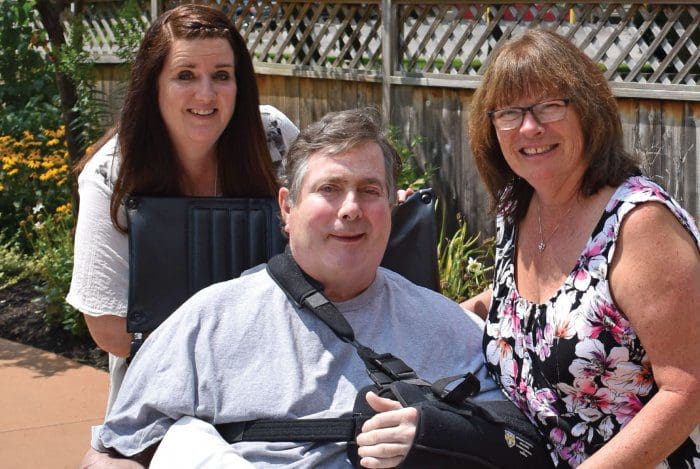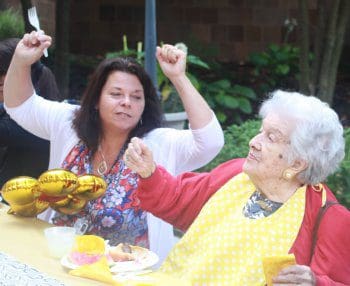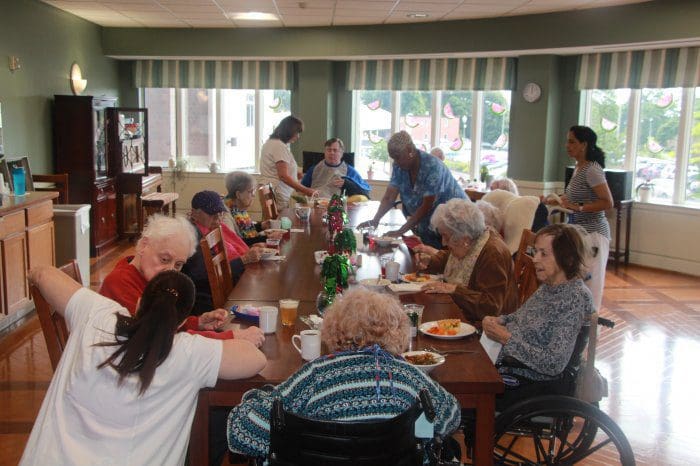Portrait of a Small Home

Charles enters the dining room and is immediately greeted by name. Diane Lochner—whose husband Larry also lives at St. John’s Home—asks Charles how he liked the neighborhood picnic in the nearby Trinity Courtyard the day before. “It was nice, but I think I may have overeaten,” Charles says with a laugh. The discussion between Charles, Diane, and Larry soon turns to Larry’s recent shoulder surgery and his continued recovery.
Across the table, Michelle sits and eats with Mary. They trade stories about their families while enjoying the day’s lunch of crab cakes and soup. Glen Campbell’s Gentle on My Mind plays in the background. As a group, elders and staff agreed to pay tribute to Campbell on the day following his death by playing his greatest hits.
This is a typical day on the Daisy neighborhood—the smallest of the small homes at St. John’s Home. Located on the first floor of the South building, Daisy is home to just 11 elders. As it is in every small home throughout St. John’s, the concept of convivium is practiced, making meal times an important part of daily life. This conscious effort to bring together the entire support system of elders living on the neighborhood has made for much more closely knit, family settings. In the case of the Daisy neighborhood, a truly intimate atmosphere has been created, giving a unique appeal to this small home that has yet to benefit from physical renovations, which have been experienced throughout several other neighborhoods in the building.
“We enjoy dining with the other residents and have come to know them and their families quite well,” says Diane Lochner. “We like the sense of community and familiarity.” Larry has been at St. John’s Home since last spring and Diane points out that he and the entire family have seen obvious benefits to living within the small homes model. “I believe it is less institutional here. The staff is more like family. When I have a concern, they listen to me and do their best to take care of the problem.”

Donna Johnston’s mother Sally also resides on the Daisy neighborhood. “It was a very difficult decision to place her in long-term-care,” she says. “But I have not for one moment regretted that decision.”
Donna references an instance that reinforced her belief that she made the right move. Donna had been noticing a change in her mom over several days and brought it to the attention of Robin, one of the nurses on Daisy. Donna recalls that Robin was very attentive to her concern and the two then discussed options to address the issue, which has since subsided. “I so appreciated her stopping everything she was doing to listen and problem-solve with me. As a daughter, that meant so much to me.”
Michelle Bullock—a nurse leader in the neighborhood—believes that the practice of convivium has contributed to the development of greater relationships between staff members, elders, and their loved ones. However, she feels it goes beyond that. “It is the way we learned to do things,” she says, noting that the Daisy neighborhood staff was the first group to go through shahbaz training at St. John’s Home. “Because of that, we’ve had a vision, and we’ve run with it.”
Michelle is quick to point out that although the dedication of the staff to the small homes mission and the support of administration have both played a pivotal role in creating this uniquely intimate setting, it all starts with those who choose to live on Daisy. “It is the elders that make this such a special place. I personally try to learn things about the people who live here so we can highlight them. We do everything we can to showcase them and make them feel important, because that’s exactly what they are.”

Like many family members of elders on the Daisy neighborhood and throughout St. John’s Home as well as the Green House Homes in Penfield, Donna believes that the concerted effort to truly know her mom as a person equips the staff to better care for her. That approach also brings greater comfort to families struggling with the decision to move their loved ones to long-term-care from their homes. Donna quotes from bestselling author and physican Atul Gawande’s book Being Mortal :
All that we ask is to be allowed to remain the writers of our own story. That story is ever changing. . . Our concerns and desires may shift. But whatever happens, we want to retain the freedom to shape our lives in ways consistent with our character and loyalties.
“I believe Daisy definitely reflects Dr. Gawande’s wish.”
